RJ45 twisted pair cable pinout: wiring diagrams and crimping rules
Power cords, like other technical accessories, fail at the most inopportune moment. But if you have crimping skills, a new connector and the necessary tool, the problem can be fixed in a few minutes.
Another difficulty is that the Internet wires are multicore, and more often than others, a cable for 4 pairs is used. Therefore, in addition to practical skills, you will need the correct RJ-45 pinout - a suitable color scheme. If you make a mistake with the distribution of conductors, you can remain without the Internet.
In this material, we will talk about the features of twisted pair cable and provide several schemes for crimping the cable.
The content of the article:
Twisted Pair Features
An ordinary electric wire, for example, VVGng 3 * 2.5 consists of three cores. This can be understood by removing the upper polymer shell. Twisted pair (in other words, a network wire, an RJ-45 cable) can consist of either one pair of wires or several.
Usually, ready-made patch cords are used - pieces of cable of standard length (on average from 0.3 m to 30 m). On both sides, the factory cord is crimped with connectors - small 8-pin plugs that can be inserted into internet outlet, connector on the router, PC, TV and other equipment.

But it is also useful to have a piece of cable not crimped in advance: for example, sometimes it is necessary to lead the cable through a small, not more than 5 mm, hole in the wall. Crimping in this case is carried out after installation.
Features of the RJ-45 Internet wire that may come in handy:
RJ-45 cable bandwidth is determined by category. In total there are 10 categories - 7 main and 3 subcategories. The first four categories are considered obsolete because they do not support the necessary data transfer speed.
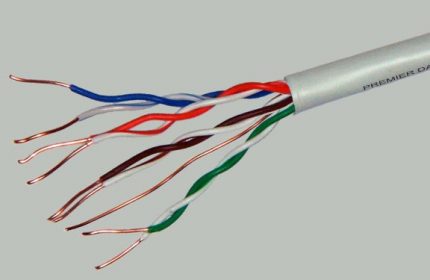
Almost all the necessary information about the cable is located on the outer sheath. The markings of different manufacturers are different, but such characteristics as category, brand code, screening method (or lack thereof), number of pairs, standard are usually indicated.
About other types of cables that are used to connect to the Internet, you can read in our another article.
Standard Crimp Patterns
The pinout of the twisted pair cable and the installation of the connectors falls under the regulation of the international standard EIA / TIA-568, which describes the procedure and rules for switching indoor networks. The choice of crimping scheme depends on the purpose of the cable and the characteristics of the network - for example, on throughput.
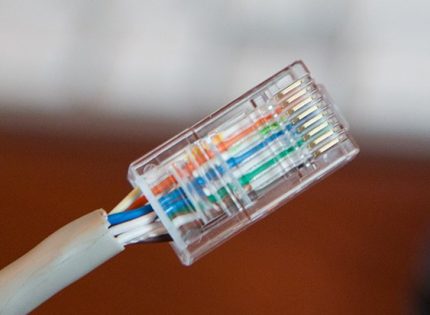
Both types of cables - from 4 or 8 cores - can be crimped directly or crosswise, as well as using type A or B.
Option # 1 - straight 8-wire cable
The direct crimping method is used when you need to connect two devices:
- on the one hand - PC, printer, copy machine, TV;
- on the other hand - a router, a switch.
A feature of the method is the same crimping of both ends of the wire, for the same reason the method is called direct.
Two interchangeable types are distinguished - A and B. For Russia, the use of type B is characteristic.
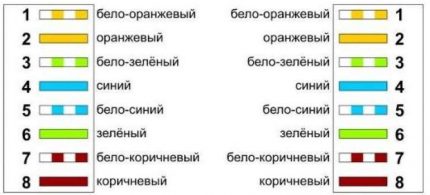
In the USA and Europe, on the contrary, crimping by type A is considered more common.
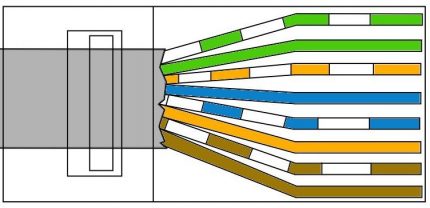
You can crimp in both ways, the data transfer quality will not be affected. The main thing is to observe the order of the veins.
Option # 2 - 8-wire crossover
Cross crimping is used less often than direct crimping. It is necessary if you need to connect two stationary computers, two laptops or two switching devices - a hub.
The crossover is used less and less, as modern equipment is able to automatically determine the type of cable and, if necessary, change the signal supply. The new technology is called Auto-MDIX.However, some home devices have been working properly for years, it makes no sense to change them, so cross crimping can also come in handy.
When cross crimping, the possibility of using types A and B.
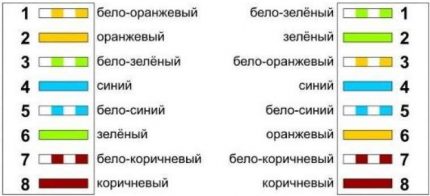
To use type A, it is necessary to change the same 4 positions: 1, 2, 3 and 6 - white-green / green conductors with white-orange / orange.
For a network with a lower data transfer rate of 10-100 mbit / s - other rules:
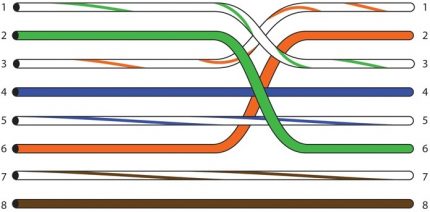
The standard A circuit repeats B completely, but in mirror image.
Option # 3 - straight 4-conductor cable
If for high-speed data transmission (for example, Ethernet 100BASE-TX or 1000BASE-T) an 8-conductor cable is required, then for "slow" networks (10-100BASE-T) a 4-conductor is enough.

If the cable fails due to a short circuit or break, you can use the free ones instead of the used conductors. To do this, cut off the connectors and crimp two pairs of other cores.
Option # 4 - 4-wire crossover
For cross crimping, 2 pairs are also used, and twists of any color can be selected. By tradition, green and orange conductors are often chosen.
The crossover crimp scheme of a 4-conductor cable is used extremely rarely, mainly in home networks, if you need to connect two old computers to each other. The choice of core color does not affect the quality of data transfer.
How to crimp the RJ-45 cable correctly?
Exist different ways to crimp the RJ-45 cable, among which there is even crimping the connector without special pliers, using an ordinary flat-head screwdriver.
But we will consider how to competently make a reliable and functional working patch cord, the characteristics of which do not differ from the purchased models.
Selection and preparation of tools
Having at hand a set of special tools, it is much easier to perform crimping operations on a patch cable. Of course, you will have to allocate the amount for the purchase of a crimper, stripper, tester or crossover, but if you buy a quality tool, it will last for years.
To properly attach the connectors to the cable, you will need:
The main of these tools are pliers and a tester - this is the minimum set necessary for the correct pinout and crimping of a twisted pair.
When buying pliers, you need to check their quality and it is advisable to pre-test the tool. Some crimpers are equipped with blades, with which you can clean the veins.
Step-by-step crimping instructions
To make a patch cord, you will need to prepare materials - cable and connectors, arm yourself with a tool and select a pinout diagram depending on which devices the finished cord will connect.
Material List:
- a twisted pair cable is no longer than 100 m - according to Ethernet pinout, this is the maximum length of standards for household use;
- for one cable - two RJ-45 connectors (their marking is 8Р8С);
- a set of tools - crimper, stripper, tester.
Most often, a cable is required to connect a PC to a network device, so we recall the direct crimping circuit, and for reliability, we simply put it in a prominent place so that it is in front of our eyes at the time the wires are distributed.
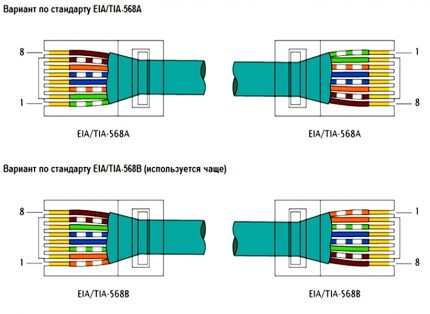
Do not forget that types A and B differ only in the arrangement of the orange and green twists, both options can be used.
Step-by-step instruction:
- Step 1 - Cut a piece of cable per meter, without stock, but of sufficient length with wire cutters or crimper blades.
- Step 2 - We retreat from the end of 2-4 cm, do stripper a circular incision on the outer insulation, and then carefully remove it.
- Step 3 - The conductors are twisted in pairs, so before crimping we untwist all the pairs, straighten the wires and distribute them according to the selected scheme. In addition to the conductors, a nylon thread hides under the sheath - you just need to lay it back.
- Step 4 - We trim the conductors. To do this, step back from the edge of the outer insulation of 1.0-1.3 cm and cut the wires with wire cutters strictly perpendicular to the axis of the twisted pair. We make sure that the colored tips are the same length.
- Step 5 - We insert the conductors into the connector and push it all the way.
- Step 6 - We make crimping: we insert the connector with the conductors into the desired crimper connector (marked 8P) and squeeze the handle of the pliers. You can hear a click.
- Step 7 - We check the reliability of fastening - easily pull the cable, as if trying to get the conductors out of the connector. With the right crimp, the cores sit firmly.
- Step 8 - Testing the finished patch cord for serviceability. We insert the connectors into the tester sockets, turn on the device and follow the indication. If everything is in order, the lights will turn green in pairs. If there is no indication or a red light comes on - the procedure will need to be repeated.
The hand is filled quickly - after several independent crimps. The crimping skill is useful when moving to a new apartment, where network wires are hidden in baseboards or sewn into walls and connected to computer outlets.
No need to worry that the cable is too long or short - you can always compress the patch cord of the desired length. If the network cable suddenly bites the dog or it just bends, you can quickly make repairs.
You may also be interested to see how you can connect a twisted pair cable to each other, for this, go along this link.
Conclusions and useful video on the topic
Short video tutorial:
Cable crimp of category 5 and 6, what is the difference:
When there are no professional tools at hand:
Knowing the twisted pair pinout, you can quickly compress the patch cord, depending on its purpose. This skill is useful to any user of personal equipment, as it allows you to quickly respond to a signal break in the local network - completely replace the network cable or make minor repairs.
Have questions about pinout of twisted pair? Please ask them in the comments box, and we will try to explain the incomprehensible points very clearly.

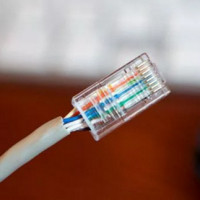 Crimping twisted pair 8 and 4 cores: basic schemes + step-by-step briefing of crimping
Crimping twisted pair 8 and 4 cores: basic schemes + step-by-step briefing of crimping 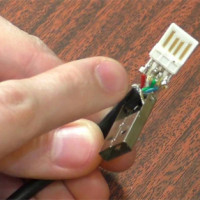 Pinout of different types of USB connectors: pinout of micro and mini usb contacts + nuances of desoldering
Pinout of different types of USB connectors: pinout of micro and mini usb contacts + nuances of desoldering 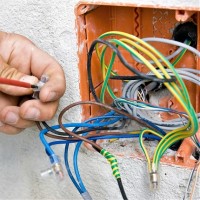 What is a vvg cable: decryption, characteristics + subtleties of cable selection
What is a vvg cable: decryption, characteristics + subtleties of cable selection 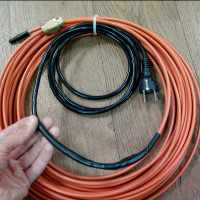 Connecting a heating cable: detailed installation instructions for a self-regulating heating system
Connecting a heating cable: detailed installation instructions for a self-regulating heating system 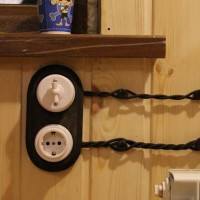 What cable to do wiring in a wooden house: types of non-combustible cable and its safe installation
What cable to do wiring in a wooden house: types of non-combustible cable and its safe installation 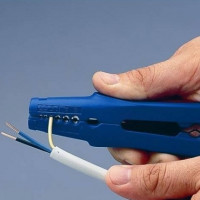 Wire stripping tool: all about cable strippers
Wire stripping tool: all about cable strippers  How much does it cost to connect gas to a private house: the price of organizing gas supply
How much does it cost to connect gas to a private house: the price of organizing gas supply  The best washing machines with dryer: model rating and customer tips
The best washing machines with dryer: model rating and customer tips  What is the color temperature of light and the nuances of choosing the temperature of the lamps to suit your needs
What is the color temperature of light and the nuances of choosing the temperature of the lamps to suit your needs  Replacement of a geyser in an apartment: replacement paperwork + basic norms and requirements
Replacement of a geyser in an apartment: replacement paperwork + basic norms and requirements
In the Internet cable, which is led into the apartment, such a strange pinout is used.
Tell me, please, what kind of sequence is this? I can not find anywhere